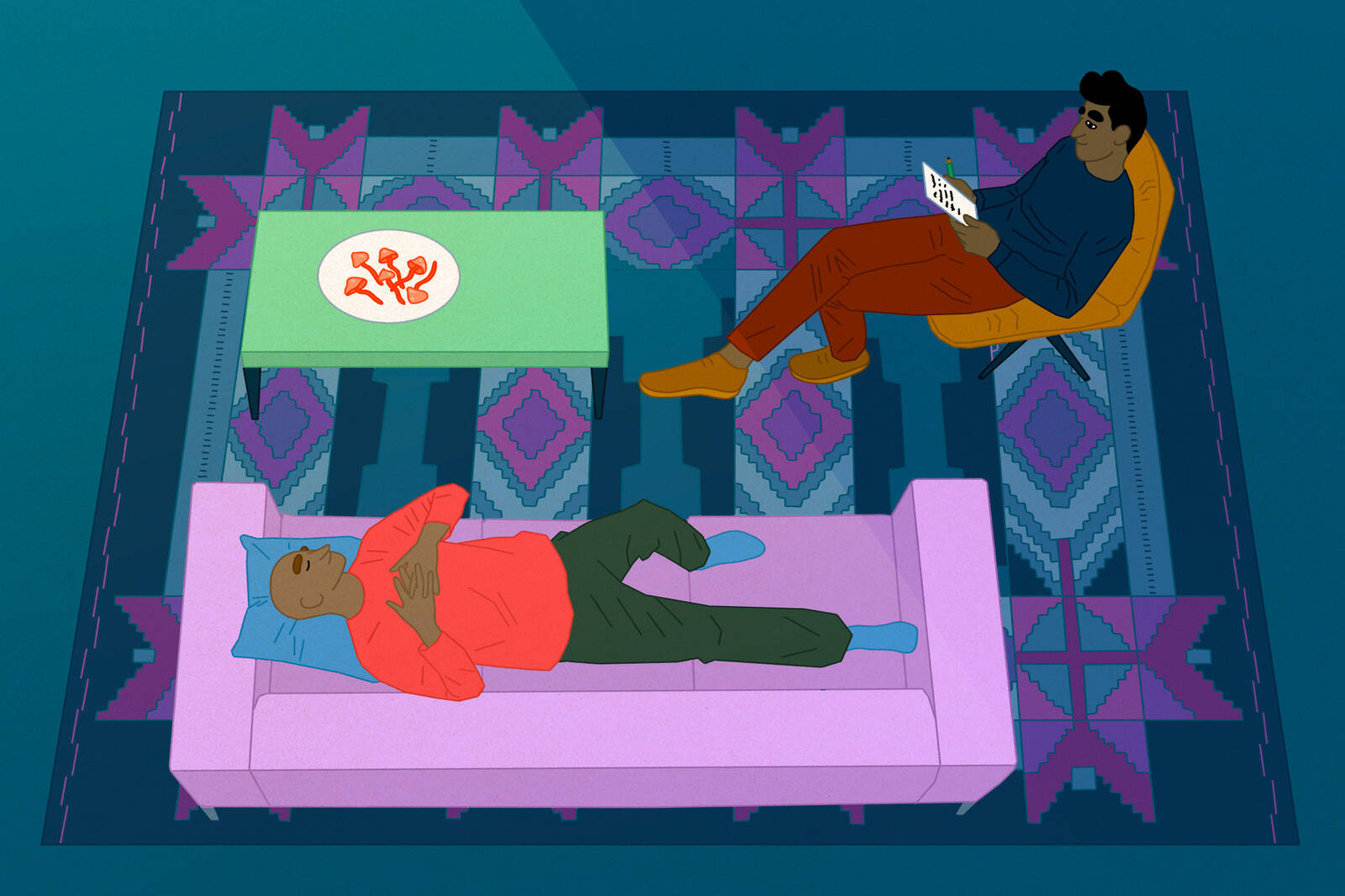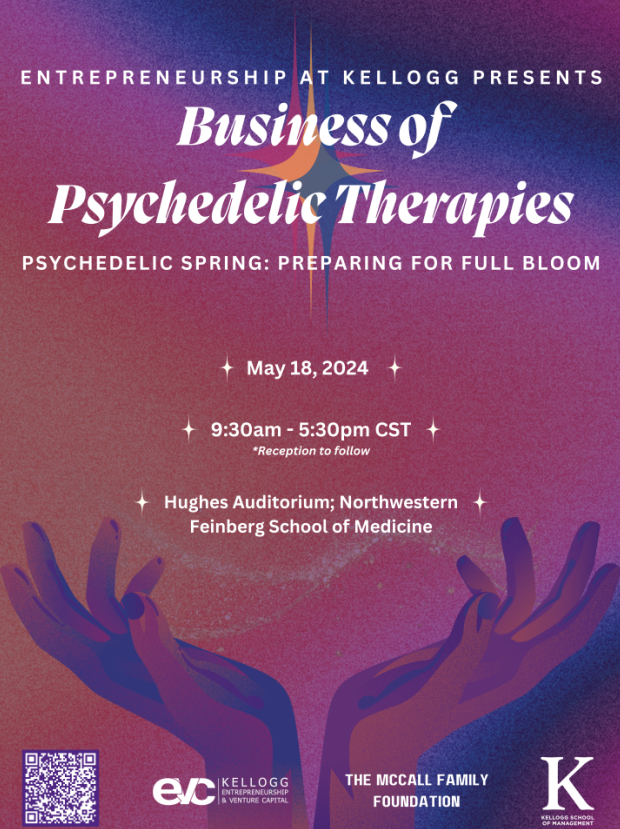Featured Faculty
Clinical Professor of Strategy; Director of Entrepreneurship Programs at Kellogg; Faculty Director of the Zell Fellows Program; Director of the Levy Institute for Entrepreneurial Practice

Lisa Röper
In recent years, psychedelics have moved beyond their reputation as the mind-expanding substances that fueled countercultural explorations. Much of this surge of interest has to do with new discoveries about these drugs’ therapeutic potential.

Recent clinical trials suggest that MDMA, ketamine, and psilocybin, when taken under medical supervision, can treat a range disorders, including addiction, major depression, and PTSD. In 2017, MDMA (also known as ecstasy) was designated a “breakthrough” medication by the FDA. Last year, a study found that ketamine might be more effective than electroconvulsive therapy in treating major depression. Meanwhile, psilocybin has been shown to ease the anxiety of terminal cancer patients. Last year, Oregon legalized its use in regulated settings.
For proponents, this research demonstrates that psychedelic-assisted therapy (PAT) might have a role to play in addressing our mental health crisis. And as states move to legalize controlled use of these substances, an industry is taking shape, with some predicting a paradigm shift on par with the rise of SSRIs or medical cannabis.
“The public discourse around behavioral health has elevated in a way where this conversation can happen now,” says David Schonthal, a clinical professor of strategy and Director of Entrepreneurship Programs at the Kellogg School. “There is a recognized need for it. And there’s a growing interest from states and insurers who recognize the power of these medicines, not just in terms of their therapeutic benefit, but also in terms of their business impact.”
But what might this industry look like? There are still significant barriers, including regulatory uncertainty, the hesitance among major insurers to cover novel medicines, and the difficulty of scaling a labor-intensive treatment method. Not to mention the PR challenge of overcoming the cultural stigmas attached to these powerful compounds.
Kellogg Insight assembled a group of entrepreneurs, philanthropists, and investors in the psychedelic-assisted-therapy industry to discuss the way the field is developing, what’s holding it back, and what to expect from the future of psychedelics.
While attempts to bring PAT into the mainstream are not new—more than a thousand studies on psychedelics were launched in the 1950s and 60s—the drugs’ associations with the 60s counterculture led to regulatory backlash. In 1970, President Nixon had psychedelics classified as Schedule 1 controlled substances, effectively cutting off research on the drugs for decades.
In the late 1990s, however, the DEA opened the door to regulatory approval again. By 2019, Johns Hopkins had launched its Center for Psychedelic and Consciousness Research, a major step in legitimizing the field.
This turn toward psychedelics reflects a broader frustration many have with the mental-healthcare status quo.
“Behavioral-health science in the United States has not been particularly well cared for,” says Michael Cotton, an investor and philanthropist who has owned and operated Medicaid-managed care plans for twenty years. “In fact, we’ve seen a lot of disinvestment in the last few decades. A lot of people don’t have access to mental health services.”
The data on mental health in the U.S. is certainly bleak, with overdose and suicide rates skyrocketing over the past two decades, despite the widespread adoption of antidepressants and other medical treatments.
The hope is that PAT, which aims to address underlying conditions through a temporary shift in the patient’s consciousness, can induce the kind of emotional and cognitive experience that leads to lasting behavioral change. For advocates of PAT, this therapeutic model, in which the medicine and therapy are administered together, has advantages over SSRIs, whose longer-term efficacy is still unclear.
“Neuroplasticity is very real,” says David Esselman, senior advisor to BrainFutures, a nonprofit focused on bringing mental-health innovations, including psychedelic-assisted therapy, into healthcare systems. “These compounds allow you to incorporate insights you have in treatment into your life. This new class of drugs could be monumentally impactful, affecting tens of millions of people.”
Despite its clinical promise, there is still the challenge of integrating PAT into existing treatment systems. Not everyone is keen to embrace a class of drugs more commonly seen at raves than in clinics. Even pioneers such as the late Dr. Roland Griffiths have said they worry about provoking another regulatory backlash by moving too quickly.
But Americans’ attitudes might be changing, especially through the adoption of psychedelics by groups not typically associated with the counterculture.
“We’re seeing resonance, particularly in more-conservative areas, around the mental-health needs of first responders and veterans,” Cotton says. In fact, U.S. veterans have been leading the lobbying effort. Women who suffer from PTSD as a result of sexual assault are also strong candidates for psychedelic treatments, as are patients struggling with addiction. Kentucky even considered putting some of its opioid settlement money toward research into psychedelic treatments for this latter group, though the plan eventually fell through.
“When you talk about these options and you show the possibilities, even those who are skeptical of psychedelic drugs see that when you take the drugs plus therapy, it’s monumentally more effective than either the drug or the therapy alone,” Esselman says. “And I think that when the FDA approves MDMA, there’s going to be a huge spike in interest.”
“The public discourse around behavioral health has elevated in a way where this conversation can happen now.”
—
David Schonthal
Still, it’s going to take more than agency approval for the industry to gain traction.
One major hurdle is the question of training and licensing for therapists. It’s not clear who would qualify to administer these drugs in a therapeutic setting or what the best practices should be. The University of Pennsylvania’s nursing program, together with Columbia’s school of social work, has begun to expand its curriculum to include training in psychedelic-assisted therapy to new nurses and social workers, but this program is still in its pilot stage. Meanwhile, those who know the drugs best tend to come from underground alternative-wellness backgrounds, making for a tricky integration into the traditional medical system.
Major insurers could represent an even larger stumbling block. “The large payers are going to be skeptical, and clinical trials won’t get them there,” Cotton says. “They want to see actual data. They want to know what to expect in terms of reducing hospital admissions or avoiding other services.”
What could push the treatment forward through traditional medical channels, however, is pressure from the business community. “There’s a growing recognition that the current mental-health crisis is now affecting our economics, our business environment, and our workforce,” says Esselman.
Indeed, Cotton says, some of the earliest proponents of psychedelic treatments are currently coming from “self-insured employer groups who emphasize the mental well-being of their employees. Some of them are already purchasing ketamine plans that are not offered by traditional insurance.”
In Oregon, the first state to legalize psilocybin, an alternative model is taking shape—one that doesn’t rely on fully integrating psychedelic therapy into the medical system.
Instead, trained “facilitators”—licensed by the Oregon Health Authority—offer what the state refers to as “psilocybin services.” Patients don’t need a medical diagnosis to participate, and facilitator certificate programs—which require anywhere from three months to a year of coursework and practicum hours—are open to anyone with a high-school diploma who has passed a background check.
“Everyone expected it to be like cannabis, where there’d be a rush of people wanting to grow mushrooms,” says Ryan Reid, the founder of Bendable Therapy‚ a nonprofit that educates and prepares potential therapy patients, and Drop Thesis, a for-profit company that includes psilocybin manufacturing and service centers. “But what actually happened was that everyone jumped in to become facilitators. By the end of this year, there might be over a thousand trained facilitators from fifteen or so different schools, but there are only about two dozen services centers licensed in the state right now. There are way more facilitators than there are service centers.”
In part, that’s because conservative county officials who oppose psychedelics have tried to make these centers economically unfeasible, as they did when the cannabis industry cropped up after legalization. “They learned how to throw enough wrenches into the works that you can’t start up,” he says.
But Reid says cannabis isn’t the best analogy for psilocybin services in Oregon, because cannabis is primarily about the sale of a product, where psilocybin is primarily about the sale of a service—facilitation—which is very labor-intensive.
When a typical PAT session—which includes preparation, dosage, and integration—is 12 hours one-on-one with a licensed professional, it’s hard to see how these service centers will be able to design their treatment systems to be sustainable. And once decriminalization expands, that may take a further bite out of the economic viability of PAT.
“I think you’ll probably end up with two-tiered market,” he says. “You’re going to have these little boutiques that offer psilocybin with a mental-health focus. And then you’ll have dispensaries for people who want the consciousness-expansion experience. There will always be demand for the mental-health-access approach, but it’s hard to keep viable.”
Cotton sees group therapy as a possible way forward. “Clinics will need to be embedded in the fabric of local communities,” he says. “Group models will be absolutely crucial, especially for lower-income communities.”
Schonthal points to Alcoholics Anonymous as an example of the power of group therapy. There’s also an interesting pharmacological wrinkle to the birth of AA. The group’s founder, Bill Wilson, credited the supervised use of the psychedelic LSD for his break with addiction.
“AA’s entire model is built upon this concept of having each other’s back. If you’re thinking about how to scale, creating a community is one way to do that.”
Whatever path the industry takes—prescriptions, dispensaries, community-based programs, or some combination of the above—there’s the question of who will benefit and who will be disrupted. The pharmaceutical industry, for example, might not welcome a shift away from Zoloft or Prozac.
“There’s no question the introduction of psychedelics upends their model,” Cotton says of the pharmaceutical industry, which has already been disrupted by patients’ increased access to cannabis.
And while psychedelic enthusiasts say their goal is to fill gaps in care created by years of disinvestment in mental-health services, it may be tough to find business models that will make a significant difference in the mental health of millions.
“Low-income, marginalized communities are where the bulk of trauma is happening. These are the communities that could benefit the most from transformational healing,” Cotton says. But finding profitable business models here is the most difficult to pull off, meaning governments and philanthropists may need to step in. “It’s going to take a lot of work to figure out how to get access to as many people as possible.”
Andrew Warren is a writer based in Southern California.